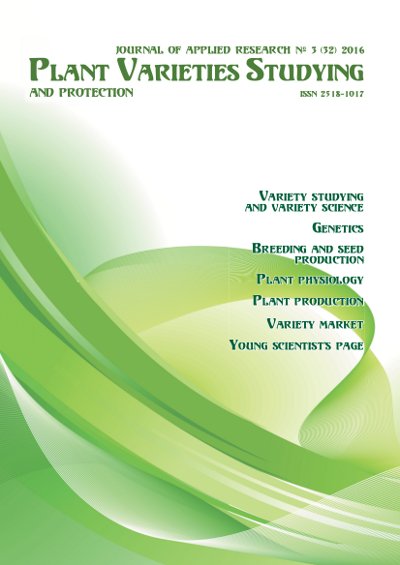Ecological plasticity and stability of new sugar beet hybrids
DOI:
https://doi.org/10.21498/2518-1017.3(32).2016.76023Keywords:
sugar beet hybrids, implementation of productivity, ecological plasticity and stabilityAbstract
Purpose. To аnalyze modern sugar beet hybrids in terms of plasticity and stability indices. To identify genotypes adapted to different soil and climatic zones on the territory of Ukraine with subsequent recommendations related to the production.
Methods. Field study, laboratory testing, analytical procedure and statistical evaluation.
Results. Features of productivity formation in new sugar beet hybrids in different soil and climatic zones of Ukraine has been studied with further recommendations for hybrids distribution in regions of sugar beet production. Response of genotype to environmental conditions change, degree of their impact on yield level, sugar content, sugar yield by hybrids evaluation in terms of ecological plasticity and stability indices was defined. According to calculations, such hybrids as ‘Novela’ (b = 1,15), ‘Protekta’ (b = 1,12), ‘Monsan’ (b = 1,09), ‘Proteus’ (b = 1,03) can be considered as highly adaptive for yield level, they require advanced agrotechnology, and only in case of observing all requirements they will produce maximum yield. ‘Proteus’ (b = 1,29), ‘Bizon’ (b = 1,26), ‘Si Belana’ (b = 1,20), ‘Protekta’ (b = 1,12) hybrids were highly adaptive for sugar content. Almost all hybrids showed high plasticity for sugar yield index, except ‘Monsan’ (b = 0,45), ‘Highland’ (b = 0,96), ‘Glorianna KWS’ (b = 0,96).
Conclusions. According to the results of investigation, one can recommend producers to use ‘Proteus’ and ‘Protekta’ hybrids that revealed a positive response to improvement of growing conditions for all studied parameters. ‘Highland’ and ‘Glorianna KWS’ hybrids are advisable to grow on extensive background where at minimum cost they will form the maximum parameter values.
Downloads
References
Kil’chevskiy, A. V. (1993). Main directions of ecological breeding of plants. Selektsiya i semenovodstvo [Plant Breeding and Seed Science], 3, 5–10. [in Russian]
Potanin, V. G., Aleynikov, A. F., & Stepochkin, P. I. (2014). New approach to the evaluation of ecological plasticity of plant varieties. Vavilovskiy zhurnal genetiki i selektsii [Vavilov Journal of Genetics and Breeding], 3, 548–552. [in Russian]
Kravchenko, R.V. (2010). Agrobiologicheskoe obosnovanie polucheniya stabil’nykh urozhaev zerna kukuruzy v usloviyakh stepnoy zony Tsentral’nogo Predkavkaz’ya [Agrobiological substantiation of obtaining stable yields of maize grain under the conditions of the Steppe zone of Central Ciscaucasia]. Stavropol: N.p. [in Russian]
Eberhart, S. A., & Russell, W. A. (1966). Stability parameters for comparing varieties. Crop Sci., 6(1), 36–40.
Tai, Q. С. C. (1971). Genotypic stability analysis and its application to potato regional trials. Crop Sci., 11(2), 184–190. doi: 10.2135/cropsci1971.0011183X001100020006x
Korepanova, E. V., & Fatyhov, I. Sh. (2012) Ecological plasticity of fiber flax cultivars under the conditions of the Middle Cis-Ural Region. Izvestiya Samarskoy gosudarstvennoy sel’skokhozyaystvennoy akademii [Samara State Agricultural Academy Bulletin], 4, 27–30. [in Russian]
Tkachyk, S. O. (Ed.). (2015). Metodyka provedennia ekspertyzy sortiv roslyn hrupy tekhnichnykh ta kormovykh na prydatnist do poshyrennia v Ukraini (PSP) [Methods of examination of plant varieties of feed and industrial group on suitability for dissemination in Ukraine]. (3nd ed., rev.). Vinnytsia: Nilan-LTD. [in Ukranian]
Vasyliuk, P. M. (2014). Assessment of stability and plasticity of productivity indices and quality of new soft winter wheat varieties under the conditions of the Forest-Steppe zone of Ukraine. Sortovivčennâ ohor. prav sortiv rodlin [Plant Varieties Studying and Protection], 1, 15–18. [in Ukranian] doi: 10.21498/2518-1017.1(22).2014.56302
Rybas, I. A. (2014). Estimation of parameters of ecological plasticity and stability of winter wheat varieties. Agrarnyy vestnik Urala [Agrarian journal of Ural], 6, 26–29. [in Russian]
Downloads
Published
How to Cite
Issue
Section
License
Copyright (c) 2016 Ukrainian Institute for Plant Variety Examination

This work is licensed under a Creative Commons Attribution-ShareAlike 4.0 International License.
Starting in 2022, the copyright to the publication remains with the authors
Our journal abides by the CREATIVE COMMONS copyright rights and permissions for open access journals.
Authors, who are published in this journal, agree to the following conditions:
- The authors reserve the right to authorship of the work and pass the first publication right of this work to the journal under the terms of a Creative Commons Attribution License, which allows others to freely distribute the published research with the obligatory reference to the authors of the original work and the first publication of the work in this journal.
- The authors have the right to conclude separate supplement agreements that relate to non-exclusive work distribution in the form in which it has been published by the journal (for example, to upload the work to the online storage of the journal or publish it as part of a monograph), provided that the reference to the first publication of the work in this journal is included.

























 Ukrainian Institute for Plant Varieties Examination
Ukrainian Institute for Plant Varieties Examination  Селекційно-генетичний інститут
Селекційно-генетичний інститут Institute of Plant Physiology and Genetics of the National Academy of Sciences of Ukraine
Institute of Plant Physiology and Genetics of the National Academy of Sciences of Ukraine
 The National Academy of Agrarian Sciences of Ukraine
The National Academy of Agrarian Sciences of Ukraine